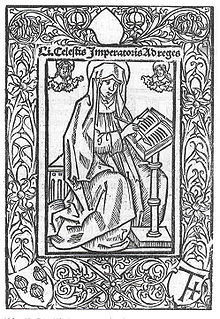Hans van Ghetelen

Hans van Ghetelen (* before 1460; † before January 31, 1528) was an incunable printer in Lübeck .

Life
Ghetelen probably comes from a Lübeck merchant family and is documented for the first time in 1480 through the acquisition of real estate in Mengstrasse as a dowry when he married; another house on Hundestrasse was also part of his property. It is not known when he learned the trade and business of book printing. He was last mentioned as alive in June 1526. In January 1528, his son Jacob was granted the certificate of inheritance.
family
Two of the other sons, the translator Henning and the secular priest Hieronymus studied at the University of Rostock; his son Augustine became a Dominican and emerged as a controversial theologian and opponent of Johannes Bugenhagen during the Reformation before he retired to Riga as a canon .
The Lübeck poppy seed dispenser
The more recent research assigns the poppy head office named afterwards as the printing workshop to him because of the correspondence between the printer's mark , which shows three poppy heads (the poppy seed capsule ) in a coat of arms, with the family coat of arms of the van Ghetelen family .
The first print of this workshop, the Middle Low German Bedeboek , dates to the year 1487. Subsequently, a number of vernacular works appeared at relatively short intervals , including some liturgical texts in 1489 under the direct impression of the Lübeck dance of death Des dodes dantz , the 1496 one received only a slightly revised new edition. Also in 1489, Thomas von Kempen's Imitation of Christ appeared in a Middle Low German version as Dat boek van der navolghinge Ihesu Christi .
The numerous other Middle Low German works from his workshop include a Speygel der leyen (1496), Dat narren schyp by Sebastian Brant (1497), the Henselynboek (after 1497) and Reynke de vos (1498), which, based on its spread in the Hanseatic region , has been a particular sales success since the 16th century and is handed down to this day as the High German Reineke Fuchs . The authors or editors formed a circle whose spiritual and spiritual center was in the Franciscan St. Catherine's Monastery and in the Devotio moderna .
The last dated prints from the workshop include a second, far simpler version of the dance of death : Dodendantz (1520). Their relationship of dependence on the printing of 1489/1496 is still controversial today.
Augustinus van Ghetelen confirms the three poppy heads in a document from the year 1542 in the Baltic States as the family coat of arms of the Ghetelen and thus clearly proves his father Hans van Ghetelen as the owner of the Lübeck poppy head office. At the same time, however, one of his typefaces also sets a new end mark for the existence of this Lübeck printing company during the early printing era. A comparison of types of his text Wedder erichteden seudebreff Imm namen ernn Johan Puggenhagen uthgeghaen Answer ... an derbaren rath to Hamborch , which appeared in print in 1526, proves the use of letters from the Mohnkopfoffizin, which were used in the Sunte Birgitten Openbaringe printed in 1496 , and thus proves this print as the (for the time being) the last of this workshop, the end of which was previously assumed in 1520.
literature
- Ahasver von Brandt : Getelen, Hans van. In: New German Biography (NDB). Volume 6, Duncker & Humblot, Berlin 1964, ISBN 3-428-00187-7 , p. 352 ( digitized version ).
- Christoph Gerhardt: Hans van Ghetelen , in: The German literature of the Middle Ages. Author Lexicon . 2nd Edition. Edited by Kurt Ruh . Vol. 3. Berlin and New York 1981, Col. 451-455
- Ralf Kötter: Hans van Ghetelen as printer of the Mohnkopfoffizin in: ZVLGA Volume 71 (1991), pp. 353-367
- Friederike Voss: The Middle Low German Narrenschiff (Lübeck 1497) and its High German templates. (Low German Studies 41) Vienna: Böhlau 1994 ( full text as .pdf )
- Dieter Lohmeier : Ghetelen, Hans van . In: Biographical Lexicon for Schleswig-Holstein and Lübeck . Volume 10, Neumünster 1994, pp. 132-135, ISBN 3-529-02650-6
- Dieter Lohmeier: Hans van Ghetelen . In: Alken Bruhns and Dieter Lohmeier: The Lübeck book printers in the 15th and 16th centuries. Letterpress for the Baltic region . Heide in Holstein 1994, ISBN 3-8042-0668-9
- Brigitte Schulte: Des Dodes Dantz, Lübeck 1489 . In: Hartmut Freytag (ed.): The dance of death of the Marienkirche in Lübeck and the Nikoliakirche in Reval (Tallinn). Edition, commentary, interpretation, reception . Böhlau, Cologne / Weimar / Vienna 1993 (Low German Studies Volume 39), pp. 345–348, ISBN 3-412-01793-0
- Olaf Schwencke : Lübeck poppy seed dispenser. In: The German literature of the Middle Ages. Author Lexicon . Edited by Kurt Ruh, Vol. 5. Berlin and New York, Sp. 927-932.
- Timothy Sodman (ed.): Dodendantz Lübeck 1520 . Facsimile edition with text, glossary and an afterword. Achterland, Vreden and Breedevoort 2001, ISBN 3-933377-00-5
Web links
- Reynke de vos ( Memento of July 10, 1998 in the Internet Archive ) - transcript of the Lübeck print from 1498 with the illustrations of the poppy head printing
- Prints by Hans van Ghetelen in the complete catalog of incandescent prints
Individual evidence
- ↑ Entry in the Rostock matriculation portal
- ↑ Ralf Kötter: Hans van Ghetelen as printer of the Mohnkopfoffizin in: ZVLGA Volume 71 (1991), p. 360 ff.
- ↑ digitized version
- ↑ Ralf Kötter: Hans van Ghetelen as printer of the Mohnkopfoffizin in: ZVLGA Volume 71 (1991), p. 362
- ↑ Ralf Kötter: Hans van Ghetelen as printer of the Mohnkopfoffizin in: ZVLGA Volume 71 (1991), p. 363 ff.
| personal data | |
|---|---|
| SURNAME | Ghetelen, Hans van |
| BRIEF DESCRIPTION | Incunable printer in Lübeck |
| DATE OF BIRTH | before 1460 |
| DATE OF DEATH | between June 1526 and January 31, 1528 |